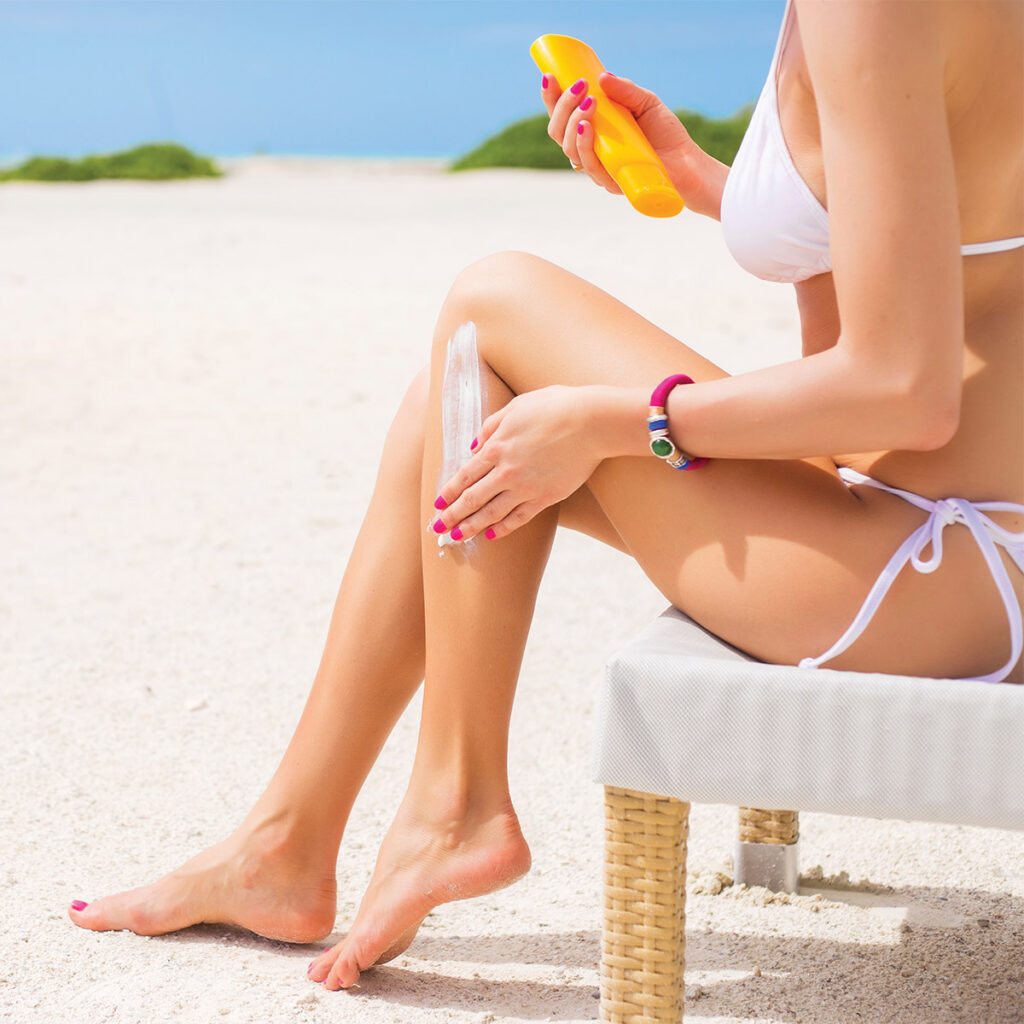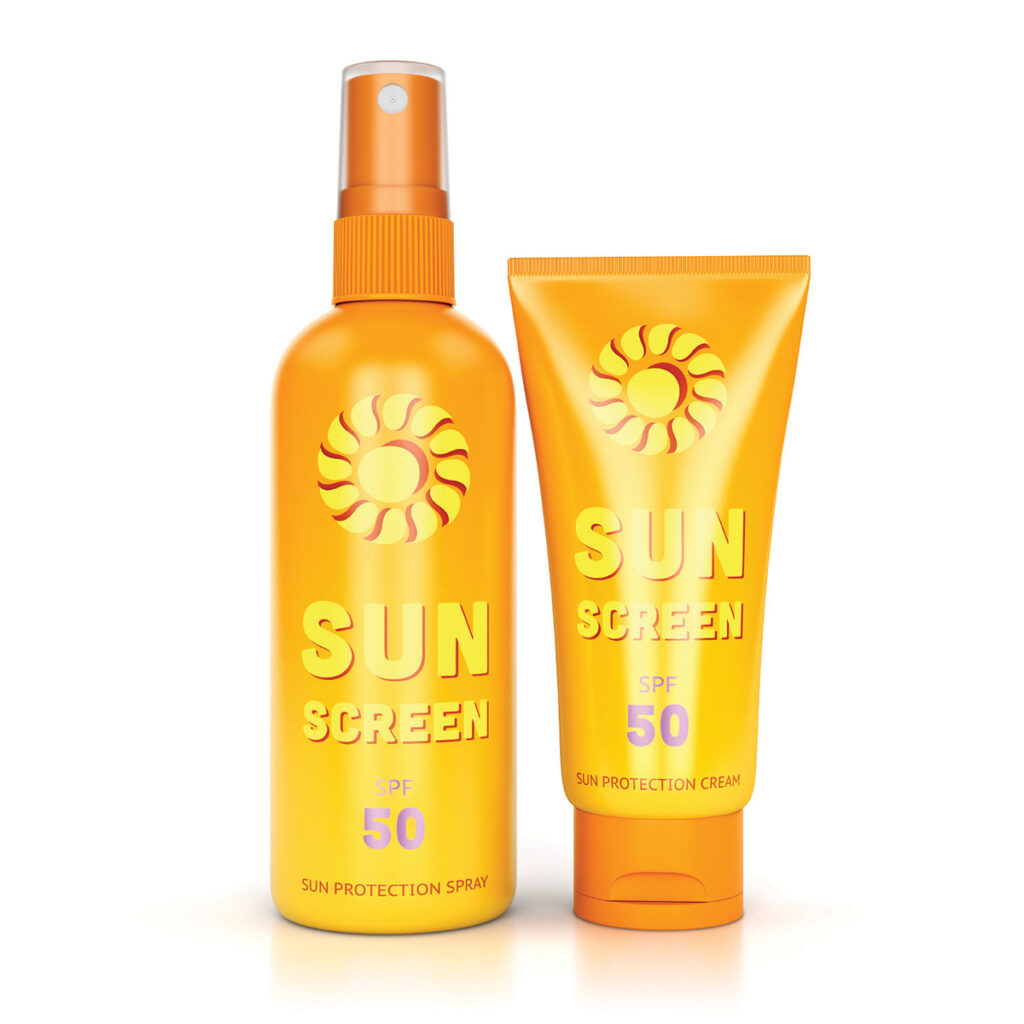Heading out to the pool or lake this summer? Before you go, here’s what you should know about sunburn, sun damage, and how to best protect your skin.
For many of us, there’s no greater feeling than basking in the rays of the sun. Whether it’s on the deck of a boat, our front porch, or a lounge chair at the pool, sunbathing can sooth our bodies and relax our minds.
“People sometimes think that you should avoid the sun completely, but that’s actually not true,” says Dr. John Chung, a dermatologist with Skin Cancer & Cosmetic Dermatology Center. “Sun exposure has many health benefits, including the formation of vitamin D which has been shown to decrease certain cancers and help with mood. In fact, it’s a good idea to get some sun every single day.”
So what’s the problem?
How Sun Damage Works

The problem lies not in the exposure itself, but in the length of your exposure. The sun’s rays are incredibly powerful and can wreak havoc on your skin if you’re outside longer than 10 to 15 minutes without protection.
As you sink into your lawn chair, novel in hand, the ultraviolet (UV) rays are penetrating deeper and deeper into your skin, damaging cells. To defend itself, your skin may release chemicals that make the blood vessels swell, which causes that painful, red, hot sensation we know as sunburn. Of course, the redness and pain of a sunburn takes between four to six hours to appear, so you may not know you have it until several hours after exposure.
Sun damage doesn’t always look like sunburn, though.
In reaction to the sun, your skin may also produce a dark-colored pigment, melanin, as a shield against further damage. So that tan you love – unfortunately, that’s also a sign of harm to your skin.
“I recommend considering the ‘dose’ of sun exposure you are allowing yourself or your family,” says Dr. Karin Covi, a dermatologist with Susong Dermatology. “You can spend hours in the sun during peak UV periods without burning if you use sunscreen, but that doesn’t necessarily mean it’s a good idea. Even a ‘tan’ represents damaged skin cells!”
Test Your Sun Care IQ
These days, we know that prolonged sun exposure can damage our skin, but do we know enough to protect ourselves? Here are some of the basic rules of sun exposure. How many do you follow?

Apply sunscreen before heading outside.
Going to the pool? Apply your sunscreen at home so it has time to soak in before you get there. ”You should apply sunscreen 20 to 30 minutes before you go outside,” says Dr. Chung.
Don some shades.
Protect your eyes with good sunglasses. The Skin Cancer Foundation recommends checking the label for proper UV protection.
Be thorough.
When applying sunscreen, don’t miss the often-overlooked spots like the ears, back of the neck, top of the feet, scalp, hands, eyelids, and lips.
Add a layer.
When you aren’t swimming, consider putting on a few extra light layers to protect your skin from the sun’s rays. ”Sun protective clothing is now readily available and comes in many different styles,” says Dr. Mary Beth Cole, a dermatologist with Dalton Dermatology & Day Spa. “Look for brands like Coolibar, Solumbra, Patagonia, and Columbia.”
Use enough.
Don’t skimp on the amount of sunscreen you use. The American Academy of Dermatology recommends using at least one ounce per application—that’s enough to fill a shot glass.
Time it right.
Avoid peak sunlight hours – 10 a.m. to 4 p.m. Plan to be outside during the morning or late afternoon and evening hours instead.
Re-apply.
One round of sunscreen won’t get you through an all-day beach or boating trip. Make sure to re-apply often, especially if you are getting wet. ”Re-applying sunscreen is so important, and it is something that often gets overlooked,” says Dr. Cole. ”You should re-apply every two hours, even on cloudy days.”

Q. Do people with darker skin still need sunscreen?
A. YES! While darker skin does offer increased protection from the sun, people with more pigmentation still get skin cancer and should protect themselves with sunscreen. “Caucasians with fair skin have the highest risk of developing skin cancer, but it can happen to anyone,” says Dr. Cole.
Picking the Right Sunscreen
Walk down the aisles of any grocery store or pharmacy and you will be inundated with sunscreen choices. Picking the right one can be a challenge. Here are some key things to look for on the label.
Broad-spectrum.
There are two types of UV light that can harm the skin—UVA, which causes premature aging, and UVB, which can burn the skin. Both can lead to skin cancer. A good sunscreen will feature broad-spectrum or full-spectrum protection, shielding the skin from both types of UV rays.
SPF.
Look for SPF 30 or higher. SPF, which stands for “sun protection factor,” measures how long you can stay out in the sun without being damaged. “SPF is about length, not strength,” says Dr. Chung. “The higher the number, the longer the protection.”
Water-resistant or waterproof.
A sunscreen that is water-resistant maintains its SPF level after 40 minutes of water exposure while a sunscreen labeled “waterproof” maintains its SPF level after 80 minutes. “If you are going to the pool or beach or you know you are going to sweat a lot, you’ll want to go with waterproof,” says Dr. Chung.

“If your job requires you to be out in the sun and you don’t have time to reapply sunscreen, use waterproof sunscreen with a high SPF,” says Dr. Chung.
Expiration date.
Throw your expired sunscreen away. It’s a good idea to restock your supply every summer.
How Cancer Begins
Every time UV rays damage your skin, it decreases your skin’s immunity and increases your risk of cancerous skin lesions. “High doses of ultraviolet light induce inflammation and cell death and damage the DNA of skin cells,” says Dr. Covi. “These effects lead to carcinogenesis – the series of steps that take place as normal cells become cancer cells.”
According to the Skin Cancer Foundation, one in five Americans will develop skin cancer. Of the more than 3.5 million cases of skin cancer diagnosed in the U.S. each year, 90% are caused by the sun’s UV rays. “UV exposure is the most preventable risk factor for skin cancer, including melanoma,” says Dr. Cole.
If worrying about skin cancer is not on your to-do list, consider how sun damage may also affect your appearance. Sun exposure also leads to photoaging—the wrinkles, blemishes, sunspots, moles, and freckles that we associate with aging skin. Many of these conditions can be prevented with basic protection too.
Checking Your Skin
Even if you’ve been vigilant about protecting your skin since the time you were a kid, it’s still important to see a physician every year for a professional skin exam. Dermatologists also recommend doing monthly self-checks of the skin to look for early signs of sun damage, including an increase in moles, freckles, brown spots, broken blood vessels, and skin roughness. “If you notice anything on your skin changing, itching, or bleeding, you should see a dermatologist immediately,” says Dr. Cole.
Another Reason To Protect Your Kids:

Did you know that we get more than 80% of our total lifetime sun exposure before the age of age 18? “The majority of skin cancers result from what we did before we reached adulthood,” says Dr. Chung.
“Cumulative UV damage, which is damage that occurs over the course of a lifetime, is responsible for instigating skin cancer,” explains Dr. Covi.
Want to Learn More?
The American Academy of Dermatology’s SPOT Skin Cancer campaign is a great resource for learning more about how to spot skin cancer and reduce your risk. Visit SPOTSkinCancer.org to learn more about skin cancer, find free screenings through an interactive map, and more!

John Chung, MD, FAAD, FACMS
Dermatologist, Skin Cancer & Cosmetic Dermatology Center

Karin Covi, MD
Dermatologist, Susong Dermatology

Mary Beth Cole, MD, FAAD
Dermatologist and Director, Dalton Dermatology & Day Spa
